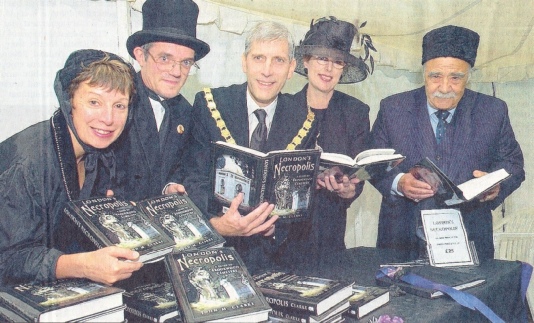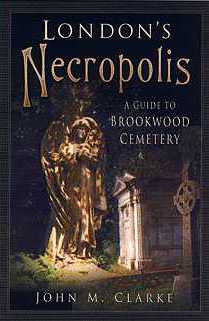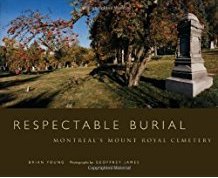

© John Clarke 2014-
John Clarke
Historian of Brookwood Cemetery

Reviews of London’s Necropolis

Cemetery Guide Goes Back in Time

The author at the book launch of London’s Necropolis at Brookwood Cemetery on July 5, 2004. From left to right, Marilyn Scott (Woking Galleries, now The Lightbox), the author, the Mayor and Mayoress of Woking (Cllr and Mrs Graham Cundy), and the late Ramadan Guney, former owner of Brookwood Cemetery.
THE first major guide to the art and architecture of Brookwood Cemetery was celebrated in true Victorian style on July 5.
History enthusiasts joined councillors, orthodox monks and the Mayor of Woking, Cllr Graham Cundy at the launch of John Clarke’s new book, London’s Necropolis.
Those attending were in traditional Victorian costume similar to the common dress of those who witnessed the cemetery’s opening during the reign of Queen Victoria.
London's Necropolis pays tribute to the cemetery which was the largest burial ground in the world when it was opened in 1854 by the London Necropolis and Mausoleum Company.
Lined with avenues of sequoia and its own railway station, the cemetery contains approximately 235,000 graves reflecting a lost society and most countries of the world.
Mr Clarke’s guide includes maps, plans and more than 100 photographs of some of the most interesting memorials. Brief biographies on 800 individuals who are buried there include Alfred Bestall -
Margaret, Duchess of Argyll, who received notoriety for the ‘headless man’ photographs, is also buried there. The photographs were used in evidence brought against her by the Duke of Argyll in their divorce case, which showed a naked Margaret pictured with a naked man whose head had been obscured.
Mr Clarke said: “I am lucky to have had the opportunity of writing the first major guide to the cemetery and I hope the guide will inspire others to take an interest in the site. The cemetery promoters have left us with a wonderful legacy and I hope it can be preserved for future generations as a World Heritage site.”
London’s Necropolis is on sale at bookstores including Ottakars, Woking.
The Woking News & Mail, 15 July 2004, p.8
* * * *
Book Reviews
London’s Necropolis. A Guide to Brookwood Cemetery by John M. Clarke. Sutton, 2004. £30.00. Hardback, 320 pp, 100 b+w illustrations.
 John Clarke is well-
John Clarke is well-
This new book brings together the results of his work on the cemetery over the last 20 years and will I’m sure prove equally popular.
In 1850 the idea of a great metropolitan cemetery, situated in the suburbs and large enough to contain all of London’s dead for an indefinite period, was promoted.
The outcome was Brookwood Cemetery, the largest burial ground in the world when it was opened in 1854 by the London Necropolis & Mausoleum Company.
The cemetery, which now contains almost 240,000 burials, is still privately owned and administered -
London’s Necropolis is a guide to the art and architecture of Brookwood, and also includes brief biographies of over 800 individuals of interest who have been buried here -
Bob Flanagan
From the Friends of West Norwood Cemtery Newsletter, No. 50, May 2004, p.10.
* * * *
Making Dry Bones Live -
The author of this book is a former chairman of Brookwood Cemetery Society which was established in 1992 to promote a wider interest in the cemetery and its history. For 27 years he has found the cemetery a fascination and an inspiration. Yet it is (he writes) one of Surrey’s best kept secrets; few seem to know of it and fewer still care about it. The book is primarily a guide to the cemetery and the author hopes it will encourage us to visit the cemetery and become convinced of its charm, beauty, and importance.
The 400 acres of the cemetery are the location of a quarter of a million graves. (Compare Highgate, London, with 37 acres and Pere Lachaise, Paris, with 118 acres and 75,000 graves.) So there is a big area to explore and a lot to see. Lack of maintenance, natural decay, and vandalism over the past 50 years or so explain much of what we see. An understanding of how this has come about, as well of the cemetery’s raison d’etre, and its layout and character, is only to be found in its history. Clarke therefore begins his book with that history and he recounts it in some detail.
That is followed by the substantive part of the book in nine chapters. Each has a plan of a section of the cemetery and describes what is to be found on a suggested itinerary. Although 80% of the quarter million burials were of paupers in unmarked graves the balance is still a huge number of persons and of (fewer) memorials. Clarke has made a selection of 800 items of which 124 are shown in photographs. Far from being a tedious list the narrative runs engagingly on, telling of the lives, achievements, glory, sometimes the shame or tragedy, of those interred or commemorated. There are many anecdotes, and quotations of notable inscriptions and, of course, one good ghost story. There are useful directions on finding one’s way and avoiding parts where the surface “is very uneven and prone to give way” -
The book is far more than a miniature Dictionary of National Biography. For instance we are told how the funerals were arranged, the seating of the parties in one example of the funeral trains from Waterloo and their reception and refreshment at Brookwood; the purpose and cultures reflected by the different areas such as the Parsees, Chelsea Royal Hospital, the military cemeteries, the Orthodox church with its royal relics, and the changing attitude of the company to cremation.
One problem is ever present in the pages, namely that of the maintenance of the cemetery and its stonework. Clarke is much more kind to the cemetery company than Alan Crosby in his History of Woking. Crosby suggests that the company was infected from the outset with an eye to profiteering from land sales. Clarke describes its philanthropic vision. Its initial object was to solve London’s burial problem for all time. Its cemetery was to be so vast that re-
On the subject of maintenance Clarke is highly critical of Woking Council. It showed no interest in this treasure chest within the borough; its planning decisions contributed rather to destruction than preservation, particularly its permission for the re-
Clarke’s reflections on maintenance lack proportion. The care of churches, graveyards, and funerary masonry is a national problem. To fund significantly the largest cemetery in Europe would impose a major burden on Woking’s council-
This book, then, is the story of the cemetery grafted on to a guide book. In both respects the book is efficient, unique, readable with pleasure, and fills a need in a creditable and workmanlike manner. It brings to our attention what we (and Crosby) sometimes overlook -
There is a reference in Ezekiel to making dry bones live. “The historian’s duty” said Philip Guedella, “is not merely to catalogue dry bones in a museum, but to make them live”. This task has been admirably achieved by John Clarke.
London’s Necropolis. A Guide to Brookwood Cemetery by John Clarke. Sutton Publishing. £30.00.
Alfred Vice
From Newsletter No. 202, February 2005 of the Woking History Society, pp.7-
* * * *
London’s Necropolis: A Guide to Brookwood Cemetery. By John M. Clarke, Stroud: Sutton Publishing Ltd, 2004, 300pp., £30.00, ISBN 0-
Respectable Burial: Montreal’s Mount Royal Cemetery. By Brian Young, Montreal: McGill-
The construction of cemeteries on a vast scale is one of the more remarkable civic endeavors demonstrating the energy of the Industrial Age. A substantial shift in settlement patterns saw rapid urban increases throughout Europe and North America; traditional churchyard provision was inadequate in its response. The cemetery was, in many senses, an industrial invention: it was a machine for dealing with mass urban mortality. These texts review the histories of two cemeteries, both laid out in the early 1850s, and both reflecting the multitude of concerns that underlay the very necessary provision of space for burial.
Neither site had in any sense a straightforward beginning. Brookwood Cemetery -
A comparison of the two books could not be straightforward as Clarke’s study is not intended as a full-
 To a large degree, Clarke is disadvantaged by the publication of a text that is very close to being an ideal cemetery history. Brian Young’s history of Mount Royal Cemetery is preceded by a series of beautiful vista photographs by Geoffrey James. These pictures -
To a large degree, Clarke is disadvantaged by the publication of a text that is very close to being an ideal cemetery history. Brian Young’s history of Mount Royal Cemetery is preceded by a series of beautiful vista photographs by Geoffrey James. These pictures -
All early-
Adding further value to what is already an excellent text, Young presents a varied range of old photographs, illustrations, and maps. Rather than giving an exhaustive ‘who’s buried where’ appendix, vignettes of individuals who are important to the cemetery’s history are appropriately scattered throughout the text and given extended captions which cross-
Julie Rugg
Cemetery Research Project, Centre for Housing Policy,
University of York, UK
From Mortality, vol. 9(4), November 2004, pp. 360-